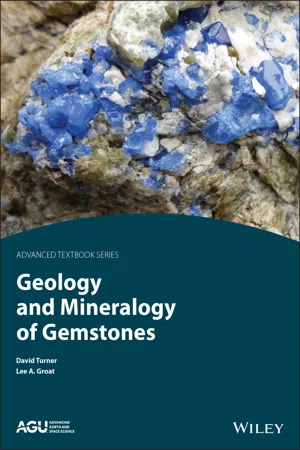1.1 Minerals and Rocks
In order to understand the world of gemstones and their geological origins, we first need to build a foundation by learning about some mineralogy concepts. Mineralogy, in its most basic definition, is a branch of science concerned with the study of minerals. Though seemingly a fairly narrow topic, mineralogy reaches far into a number of other disciplines from medicine (e.g., effects of mineral fibers on lungs) to ceramics (e.g., firing of clay‐based pottery) and the origins of the Earth itself (e.g., mineral inclusions trapped in diamonds). This book focuses on understanding the geological origin of gemstones, most of which are natural materials known as minerals and are found within rocks. Before deciphering their origins, we must understand gemstones as minerals.
A lengthy yet concise definition of the term mineral is:
A mineral is a (i) naturally occurring, (ii) solid with a (iii) definite (but generally not fixed) chemical composition, and a (iv) crystalline structure. It is usually formed by (v) inorganic processes.
The International Mineralogical Association lists 5,673 distinct mineral species as of early 2021 and there is active research to understand how the diversity of mineral species has changed through time (Hazen et al., 2015). Rocks can essentially be thought of as (i) naturally occurring aggregates of (ii) one or more mineral species held together through interlocking grains. It is important to note that rocks and minerals are natural solids and usually formed by inorganic processes. Materials made by people in a laboratory or elsewhere, such as synthetic crystals, would therefore not qualify as rocks or minerals though may share some similar properties. Since most gems are minerals, this clearly defined way of looking at minerals allows us to easily differentiate a valuable ruby gemstone from common red glass.
1.2 What is a Gemstone?
As a general statement, gems are minerals that originated from an original source rock and are valued for their aesthetics. There are exceptions and the definition of the term “gem” is in reality much more broad. A gemstone (the words gem and gemstone are commonly interchanged) is any mineral or material that is highly valued for its beauty, durability, and rarity. Included in the mineral‐focused gemstone definition are nonmineral gemstones that are organic or biological in origin, such as pearls and amber. There are a few rocks that are also considered gemstones, such as lapis lazuli and jade, as are some naturally occurring cryptocrystalline materials, such as agate. The study of gemstones is the field known as gemmology and is largely based on principles of mineralogy as applied to gemstones, However, it is an important distinction that gemstones can be more than minerals, which then necessitates study beyond minerals.
Gemstones earn their value primarily through subjective factors, including historical and cultural values, as well as through marketing and influence. Objective factors that contribute to a gemstone’s value include its hardness, toughness, and rarity, and gemmological factors like clarity, size (measured in “carats”, where 1 carat = 0.2 grams), and the cut of a specific gemstone itself. Combined, these factors suggest that as world supplies of gemstones ebb and flow and cultures change, so can the value of all gemstones. Nevertheless, some gemstones retain their importance. Geologist Sydney H. Ball provided an insightful quote from his 1935 article titled “A Historical Study of Precious Stone Valuations and Prices” that is still valid today, over 80 years later:
Exceptionally fine gems are so rare that they have no fixed price, and each transaction becomes a matter of negotiation between buyer and seller. As with a fine painting or other work of art, set rules do not hold. Such are red, green, or blue diamonds, white diamonds of unusual size and brilliancy, rubies of over four carats, emeralds of fine deep color and relatively free of flaws, particularly if of good size, and unusually fine sapphires.
(Ball, 1935)
Synthetic crystals are not considered minerals but can be considered as gemstones; however, their trade names should always be preceded by the word “synthetic” or an equivalent term. The acceptance of synthetic crystals in the gem trade is mixed, with some people rejecting human‐made materials altogether and others arguing they are just as valid as natural gemstones. The middle ground is occupied by most professionals and they accept synthetics as gemstones so long as they are designated as such (e.g., “synthetic ruby” or “laboratory‐created emerald”). Imitations, on the other hand, are inexpensive materials that are designed with the intent to mimic a gemstone of greater value. A range of treatments can also be applied to many gemstones. Treatments can be as simple as heating to influence the overall color to more sophisticated recipes, including subjecting gemstones to complex heating, irradiation, and pressure conditions in a specific order to achieve specific results.
1.3 Atoms, Elements, and Bonding
All matter is composed of particles known as atoms. Atoms are made up of protons, neutrons, and electrons. Elements are collections of these particles (i.e., an atom) and their identity is defined by the number of protons. Atoms can combine through chemical bonding to form specific chemical compounds. Minerals are collections of atoms arranged and bonded together in specific ways.
1.3.1 Protons, Neutrons, and Electrons
The identity of an atom is determined by the number of protons it contains – this is also called the element’s atomic number. For example, the first element of the periodic table is hydrogen (H), which has an atomic number of 1, which means it has one proton. The second element of the periodi...
